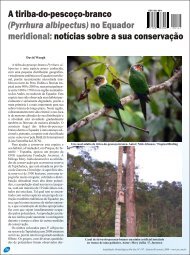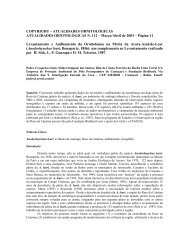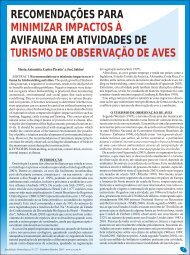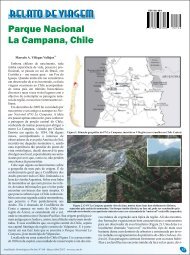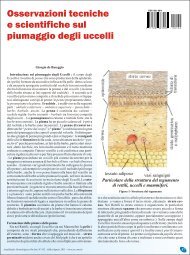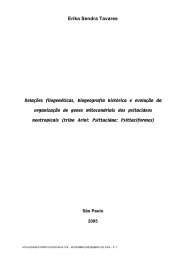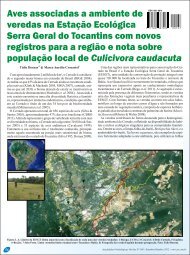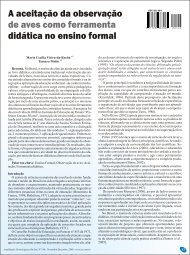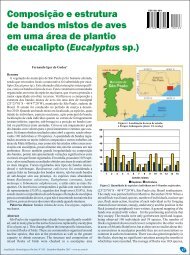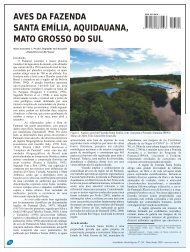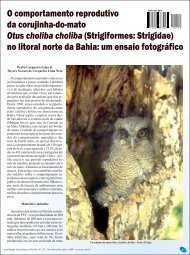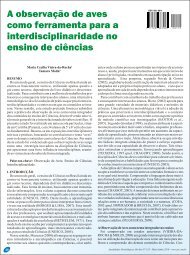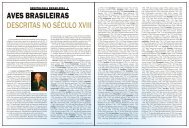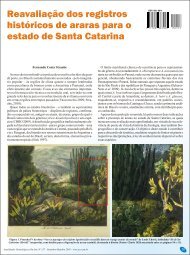História da ornitologia no Paraná. Período de Natterer, 1
História da ornitologia no Paraná. Período de Natterer, 1
História da ornitologia no Paraná. Período de Natterer, 1
You also want an ePaper? Increase the reach of your titles
YUMPU automatically turns print PDFs into web optimized ePapers that Google loves.
Sicherheit als Weibchen bezeichneterVogel fin<strong>de</strong>t, welcher <strong>da</strong>s Roth amSchwänze wie die Männchen zeigtDagegen fehlt <strong>da</strong>s Roth bei einemangeblichen Weibchen ohne Angabe <strong>de</strong>sFundortes, bei Männchen von Ypanema(September, October), Curytiba, Borbaund Marabitanas, ferner bei einigenIndividuen, <strong>de</strong>ren Fundorte nichtfestgestellt sind.tenha sido reconheci<strong>da</strong> como tal eapresentando um tom avermelhado nacau<strong>da</strong>, o que não ocorre em nenhum dosmachos (e também em uma provávelfêmea sem indicação <strong>de</strong> locali<strong>da</strong><strong>de</strong>). [Asérie] consta <strong>de</strong> machos oriundos <strong>de</strong>Ipanema (setembro, outubro), Curitiba,Borba e Marabitanas, além <strong>de</strong> algunsindivíduos sem procedência indica<strong>da</strong>.”Myiarchus swainsoni Cabanis & Heine, 1859 [em parte] eMyiarchus ferox (Gmelin, 1789) [em parte] 151Myiarchus cantans Pelzeln n.sp. (p.117; 182)L: Curytiba (outubro e <strong>no</strong>vembro <strong>de</strong> 1820) 152―Curytiba October in nie<strong>de</strong>rem GehölzNovember‖“Curitiba em outubro, em matas baixas em<strong>no</strong>vembro”Sirystes sibilator (Vieillot, 1818)Sirystes sibilator (Vieill.) (p.111-112)L: Curytiba (outubro <strong>de</strong> 1820)Myiodynastes maculatusMyiodynastes solitarius (Vieill.) (p.112)L: Curytiba (outubro e <strong>no</strong>vembro <strong>de</strong> 1820)―...sitzt ruhig wartend aufvorüberfliegen<strong>de</strong> Insecten (CurytibaOct.)‖“…pousa calmamente à espera <strong>de</strong> insetosvoadores (Curitiba, outubro)”.151 Segundo Lanyon (1978:512 e 579), Pelzeln usou exemplares <strong>de</strong> ambas as espécies para<strong>de</strong>screver M.cantans; a primeira <strong>de</strong>las alu<strong>de</strong> à forma M.s.swainsoni e, a segun<strong>da</strong>, aM.f.australis.152 No anexo: “Beschreibung neuer o<strong>de</strong>r wenig gekannter Arten” (Descrição <strong>de</strong> espécies<strong>no</strong>vas ou pouco conheci<strong>da</strong>s), consta a <strong>de</strong>scrição original <strong>da</strong> espécie e medi<strong>da</strong>s dosespécimes. Inclui um “<strong>Natterer</strong>‘s Notizen: Ex. (auf einem nie<strong>de</strong>ren Baume, Curytiba,October). Iris dunkelbraun, Schnabel schwarzbraun, die Wurzel <strong>de</strong>s Unterschnabels etwasin Röthlichbraun übergehend, Nasenlöcher rund, offen, Wurzel <strong>de</strong>r Schnabels mit ziemlichgrossen Borsten besetzt, Füsse schwarz” [...] “Männchen (Curytiba in nie<strong>de</strong>rem Gehölze,November) [...] ―Gesang melodisch (Curytiba, October)‖. (“A<strong>no</strong>tações <strong>de</strong> <strong>Natterer</strong>:Ex.[emplar] (em uma árvore baixa em Curitiba, outubro). Íris marrom escura, bico marromenegrecido, com a base marrom-avermelha<strong>da</strong>, narinas redon<strong>da</strong>s, base do bico revesti<strong>da</strong> porcer<strong>da</strong>s muito longas, pés negros”).132



